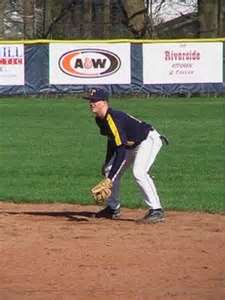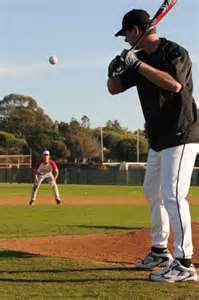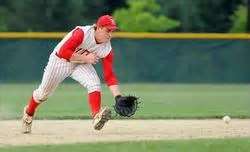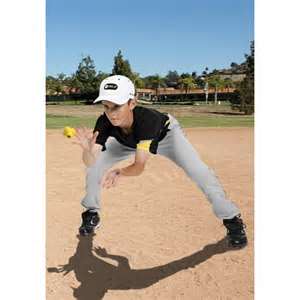Baseball-Practice-Drills
Some infield Baseball-Practice-Drills can be performed indoors as well as out because they require little room to perform. I always tried to practice under “game conditions,” there’s nothing quite like feeling grass under your spikes, but some drills are just as beneficial practiced inside.
From an infielder’s perspective there’s very little that strikes fear into the heart more than the Short Hop, whether hit hard or at medium speed.
(1.) The initial fear with fielding short hops is actually the Indecision, do I charge the ball or lay back?
(2.) As a rule of thumb, you are always better off charging the ball.
(3.) By moving forward on the ball you naturally tend to stay low, a Major factor in fielding;
(4.) You’re on the balls of your feet balanced and able to alter directions quickly, unlike being back on your heels waiting for the ball.
Baseball-Practice-Drills

Adopting the philosophy of always charging the ball the next step is to develop Quick hands and feet and the following drills will help accomplish that.
Short Hop Drill One:
I like to break short hop training into several segments of practice, then bring them all together in the end. The first segment is using the glove Only to field the ball, which teaches how to develop a Quick glove.
In order to do this, the bare hand must be taken out of the equation of the fielding process. I’ve seen coaches have players place their throwing hand behind their hip or lower back which definitely works and is not wrong, but I question the issue of balance with this approach, especially with younger players.
I suggest to have the player hold a baseball in his bare hand, yet still position it above the glove as if it were going to be part of the fielding process. The hand can not assist because it’s in a fist, the fingers must wrap around the ball in order to hold it, which eliminates the possibly of taking a ball off the finger tips if they are dangling loose.
Baseball-Practice-Drills

(1.) Have 2 players facing each other spaced about 10-12 feet apart. One player throws, the other fields for a specified number of reps or time length, then switch.
(2.) The player bounces balls hitting 1-2 feet directly in front of the fielder, simulating short hop ground balls.
(3.) The fielder catches the ball with the glove only; It’s important the open palm of the glove faces the ball, which offers the most amount of glove surface to cleanly field the ball.
Clickbank Products
(4.) In order to increase confidence and manual dexterity with the glove hand; use the glove to return the ball to your partner. This glove flip is utilized in quickening double play speed when the situation requires it and this is excellent practice for that maneuver.
(5.) After completing 10 or more reps of hops directly at the fielder, switch to throwing to the forehand, left of the body, or back hand, right of the body.
Short Hop Drill Two:
The next step to improving your infield abilities is the development of Quick feet. Having quick, sure hands is of little benefit if you’re unable to close on the ball and be able to reach it.
Again, we eliminate the bare hand from the fielding equation in the same manner as before, holding a baseball. Using the glove only to catch the ground ball forces you to get into the best fielding position, which 99% of the time is in front of the ball, which means you’ll have to move your feet and move them quickly.
Baseball-Practice-Drills

Again, this drill can also be performed indoors, but requires much more room. Players should be 70-90 feet apart.
(1.) One player throws or hits a ground ball directly at the fielder;
(2.) The fielder positions himself and catches the ball with only the glove;
(3.) After becoming accustomed to the drill, the balls are to be hit or thrown to each side of the fielder and varying speeds.
(4.) Remembering this is a speed foot drill, it’s more important to concentrate on increasing the distance the fielder must move, rather than the speed of the ball.
The goal of the fielder is to not only catch the ball, but position himself In Front of the ball in order to make the catch the easiest possible.
Wall Ball: Baseball-Practice-Drills
Here’s a fun drill which increases players’ foot speed and teaches soft hands, no gloves allowed. Use a ball which bounces quickly, a hard rubber ball, racquet ball or brand new tennis ball. Speed is essential.

Baseball-Practice-Drills
(1.) Position 4 to 10 players, it’s totally at your discretion, in a line facing a wall 25-30 feet away. This distance can also be altered at your discretion.
(2.) Beginning on the left, have the first player throw the ball, hard, against the wall, catch the return bounce, and throw the ball against the wall again;
(3.) On the second throw the player moves off to his left or backwards, and the player immediately to his right quickly moves over to catch the bouncing ball;
(4.) This player repeats the throw catch, throw move and the next player moves over to catch the ball;
(5.) After completing the drill, reverse the drill starting on the right.
(6.) There’s several ways to enhance the drill;
a. Increasing the distance players are apart requires them to move faster in order to get into fielding position;
b. being closer to the wall makes the speed greater;
c. Use black tape to frame a box on the wall which everyone tries to hit which increases throwing accuracy.
Due to the stress on Speed … the players are throwing hard and accurately, they field and throw in one motion, the next player must quickly get into fielding position, and by rotating left then right, the players experience moving quickly to both sides of their body.
Baseball-Practice-Drills to baseball practice drills

New! Comments
Have your say about what you just read! Leave me a comment in the box below.